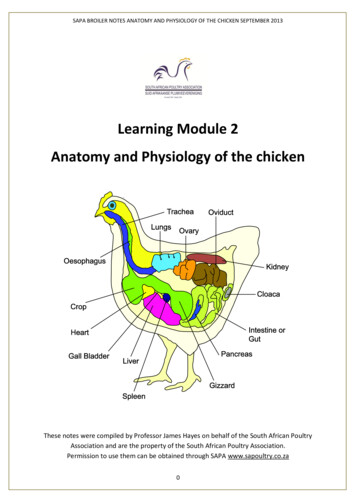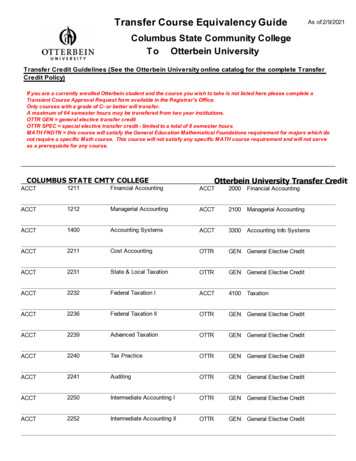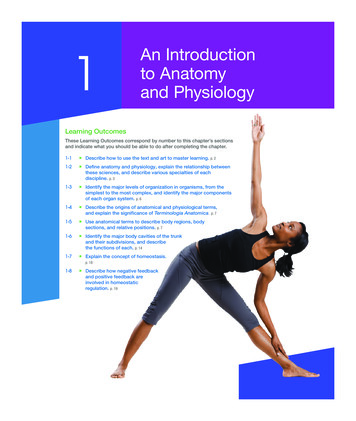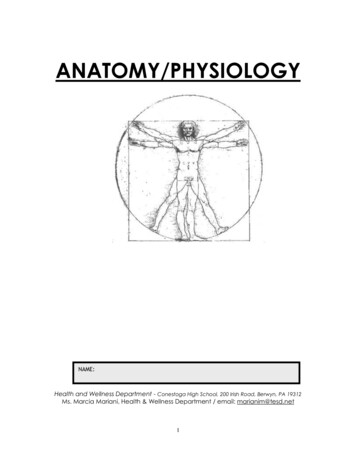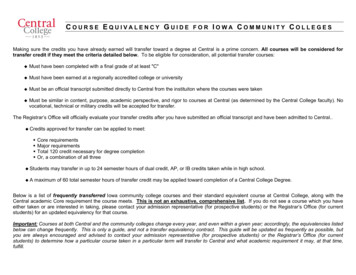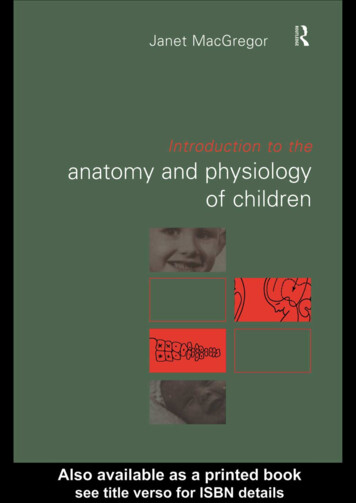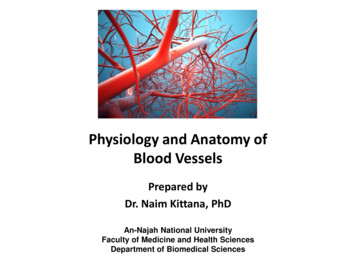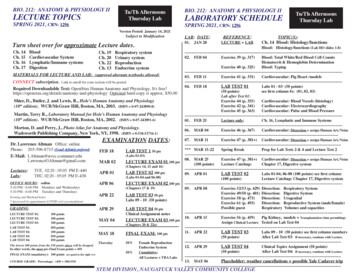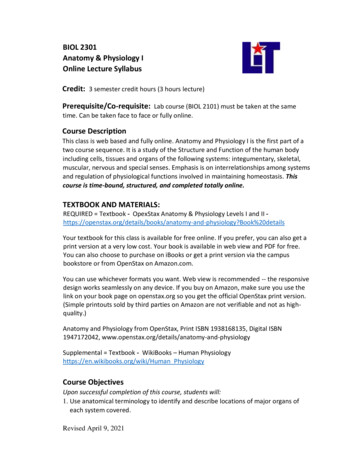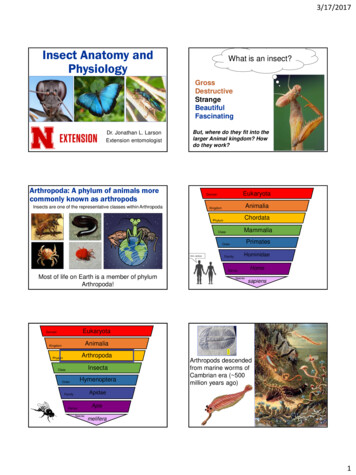
Transcription
3/17/2017Insect Anatomy andPhysiologyWhat is an Dr. Jonathan L. LarsonExtension entomologistBut, where do they fit into thelarger Animal kingdom? Howdo they work?Arthropoda: A phylum of animals morecommonly known as arthropodsEukaryotaDomainInsects are one of the representative classes within ssPrimatesOrderOoh, rainbowHominidaeFamilyGenusMost of life on Earth is a member of teraOrderArthropods descendedfrom marine worms ofCambrian era ( 500million years ago)ApidaeFamilyGenusSpeciesApismelifera1
3/17/2017Once upon a time Precursor to insects?Onychophora Articulatedappendages MouthpartsEnid, the ancestor to arthropods May be earlyancestor or sistergroupVelvet WormFirst known land animalPneumodesmus newmaniArthropodaUniting traits of arthropodsFirst is hidden in the name CheliceraGreekἄρθρον; árthron: meaning jointπούς; pous (podos): meaning footArachnids Merostomata1. All arthropods have jointed appendages2
3/17/20172. All arthropods have bilateralsymmetry3. Arthropods have segmentedbodies4. Arthropods have an exoskeleton, awaxy cuticle over whole eliceraArachnids Merostomata“A suit of armor” provides protection from attack or injury,Muscles attach directly to the body wall, stops fluid lossArthropods with chelicera lack jaws,chelicera can chop food/inject venomThe end result of feeding can be acrunched up ball or a hollow bodyMerostomata (Thigh mouth): Seascorpions and horseshoe crabsAll have book gills, 6 pairs of appendages,and a pair of compound eyes3
3/17/2017Only extant members of merostomataare the horseshoe crabsArachnida (Spider): All arachnidsScorpionesHave been around for 450 million years, areconsidered living fossilsTraits: 2 body segments, noantennae, 4 pairs of legsMyriapoda (Many legs): Centipedes andtheir cousins the millipedesCentipedesCommon traits: 1 pair ofantennae, 1 pair of legs perbody segment, flat bodies,venomous jawsAcariAraneaScorpions, ticks, mites, spiders, etc.All other arthropods have mandiblesbyfir0002Crustacea (Hard shelled ones):Crayfish, lobsters, shrimp, etc.MillipedesCommon traits: 1 pair ofantennae, 2 pairs of legsper body segment, roundbodies, decomposersCommon traits: 2 body segments, 2 pairs ofantennae, 5-7 pairs of legs, swimmerets or gills4
3/17/2017Insecta (Cut into sections): All ofthe insectsCommon traits: 3 body segments, 1 pair ofantennae, 3 pairs of legsMost biodiverse group on Earth: There aremore than 1 million species identifiedPhotos by Alex Wild:http://www.alexanderwild.com/Despite looking wildly different, these are all insects!!Possibly upwards of 30 million speciesin existenceDaly (1978)How to build a bug!Just let me fasten thesetogether, then we canget lunch.We will remove some of themystery of insectsTa-da!Understanding insect anatomy helps with identificationand pest management strategies5
3/17/2017Insects have 3 distinct bodysectionsThe Head: Serves as the center for sensoryinput from sensory organsRhettStuartAlso houses the insect’s largest ganglionSome have ocelli, or simple eyes. These perceive light and darkInsects have one pair of compoundeyesJJ HarrisonMade up of many facets that create a composite imageCompound eyes detect movement,make insect nearsightedInsects also perceive colordifferently than us6
3/17/2017All insects come with a pair ofantennae, located on headAntennae are forsmelling, touching, andeven hearingAntennae also detect pheromones (ahormone that affects fellow individuals)AggregationTrailAlarmAntennae can tell the insect they aretouching something delicious to eatOr, could help them orient towards a food sourceAll antennae are divided into 3 partsEpideicticSexualPheromones differ from sight or sound signals as they travelslowly, do not fade quickly, and are effective over a long rangeFiliform antennae: Segments are samesize, threadlike in appearanceScape, pedicel, and flagellum; will help withidentification!Pectinate and PlumoseSuggestive of a combMost common type of antennaeFeather-likeLots of surface areas to pick up more info7
3/17/2017Serrate and LamellateSaw likeFan-like, pages inbookGeniculate aka elbowedInsect mouthparts come in manyshapes and size, can be diagnosticAristate and SetaceousA balloon with a plumose antennaeLike a thin mustacheOnly on fliesOn fast fliersCapitate and ClavateChewing mouth: Most commonAppears in many groups, both herbivores and predators8
3/17/2017Chewing mouths lead to many different types ofdamage/symptomsPiercing-sucking: 2nd most common,can be used on plants or on animalsTexas A&MBedbugsinNYC.comNeedle like mouthparts used to siphonfluids for foodPiercing-sucking createsdistinctive damage as wellPlant damageSponging mouthparts: Must liquifyyour food firstSkin damageFound mainly on fliesSiphoning mouthparts: Straw likeproboscis for liquid foodFound mainly on butterflies and mothsChewing-lapping: Used to consumeboth pollen and nectarWasps, bees, and few others9
3/17/2017Thorax: Main purpose is for locomotion, theinsect’s legs and wings are located hereInsects are the only invertebrates tohave evolved wingsPurdueWings are usually membranous with veins, wingfolding is more advancedNot all insects have wings thoughAll insects have 3 pairs ofjointed legsSome have no wings at all, others only have wingpads and they don’t developThorax is a cylinder with 9 piecesWe aren’t so different axMeta-legsTarsiPre-tarsi10
3/17/2017Ambulatory Legs: Cursorial, walking,running, or simple legsTripod walkingmotionNC StateMost common of all legsSaltatorial Legs: Jumping legsBuilt very similar to walking legs, difference lies infemurDifferent places, different clawsClasping: Leg with femur and tibiaformed into pincer like structureCommon in lice, used to grasp on to differentsurfaces.Natatorial Legs: Swimming legsJ. M. BatesLeg flattened into a paddle like organ, typicallyhairy as wellBird louse on featherHead lice on human11
3/17/2017Fossorial Legs: Digging legsTibia or tarsi modified into scraper likeorganRaptorial Legs: Grasping legsAbdomen: “The business end”Externally: Tympanum, spriaclesCronodonLegs are armed with opposing spines orspurs on the femur & tibiaExternal anatomy: At the posterior end ofthe abdomen may be cerci or an ovipositorCerciOvipositorTactile organs, sort oflike butt antennaeSword like egg layingdevice, can be defensiveInternally:A little bit of: cardiac, nervous, respiration,digestionMostly: sexual reproductionTympanum: The main type of hearingorgan, located externally on abdomenA membrane stretched across an air sac, it isvibrated by sound similar to our ear drum12
3/17/2017Insect Respiratory System: A complex ofnetworked tubes known as a tracheal systemSpiraclesSpiracleSpiracles are the valve like opening where air enters the bodyInternal anatomy: Compared to us, thenervous system and circulatory system arereversedInsects have an open circulatory system,this means their “blood” is free floating,contacting organsThe hearts in the abdomen help pump the fluidforward into the aortaHemolymph: Insect bloodCarry nutrients to tissues, carry awaywastes, function in phagocytosisInsect Nervous SystemMore brains than us! Have several gangliato control particular organsInsect blood cellsthat have engulfedbacterial or fungalinvadersUnlike human blood, insect blood cells lackhemoglobin and do NOT carry oxygen13
3/17/2017BrainVentralnerve cordTracheaeInsect digestion: Insects have a “complete digestivesystem”, meaning there is a mouth and anus rather thana combined organ“The scene seen through my macro tube was quite horrifying, alsobecause in this case, the female started eating her partner before themating, beginning from his mouth, after immobilizing his claws, in orderto leave him without defenses. After that, the male, totally deprived of hishead, completed the mating, while the female continued eating him”Insect Reproductive SystemsMost insects use dneys”The abdomen contains the midgut, where most digestion occursand the organs responsible for waste production and disposalInsect Reproductive SystemsInsect Reproductive Systems14
3/17/2017After mating most females will laytheir eggsDepending on the insect and its location, the eggsmay hatch quickly or overwinter2 types of development in insects, Complete and Incomplete Metamorphosis15
Internal anatomy: Compared to us, the nervous system and circulatory system are reversed The hearts in the abdomen help pump the fluid forward into the aorta Insects have an open circulatory system, this means their “blood” is free floating, contacting organs Hemol

